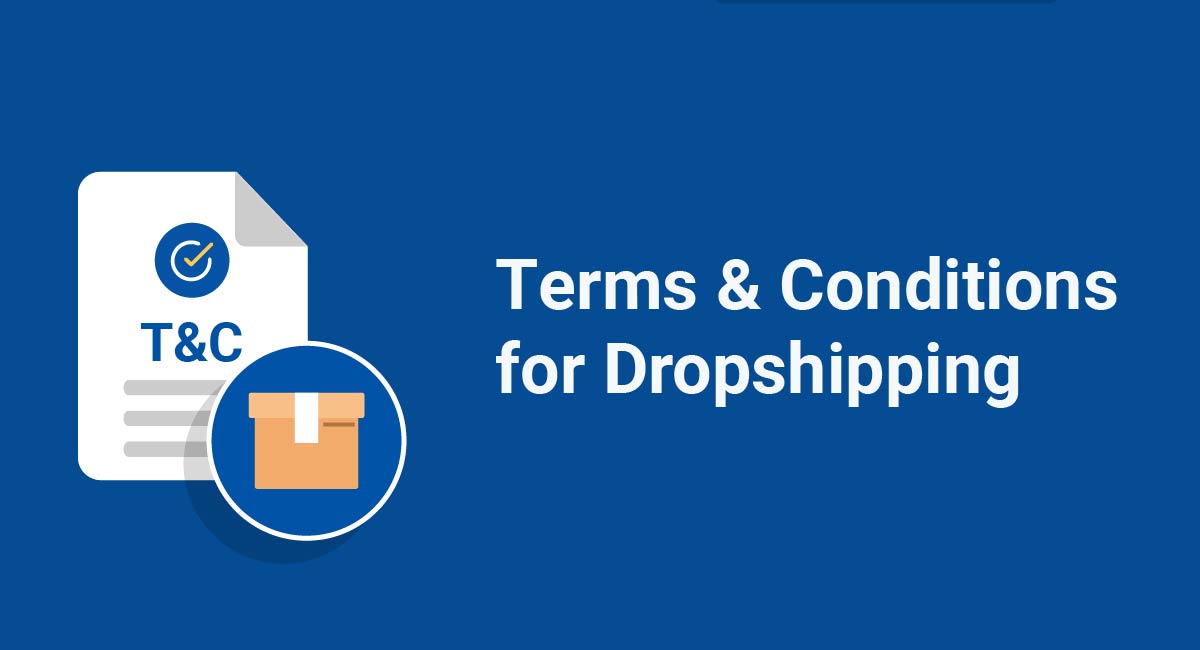

If you're the owner of a dropshipping store, your website should have a Terms and Conditions agreement (T&C). It's not a legal requirement, but it is very beneficial for you to have.
For instance, a Terms and Conditions agreement can help protect you legally, limit your liability should something happen during the dropshipping process, set out rules that your customers need to follow, and what remedies are available if legal conflicts occur.
In the article below, we'll discuss why a Terms and Conditions agreement is something your dropshipping store should have, what you should put in it, and where you should display it.
Our Terms and Conditions Generator makes it easy to create a Terms and Conditions agreement for your business. Just follow these steps:
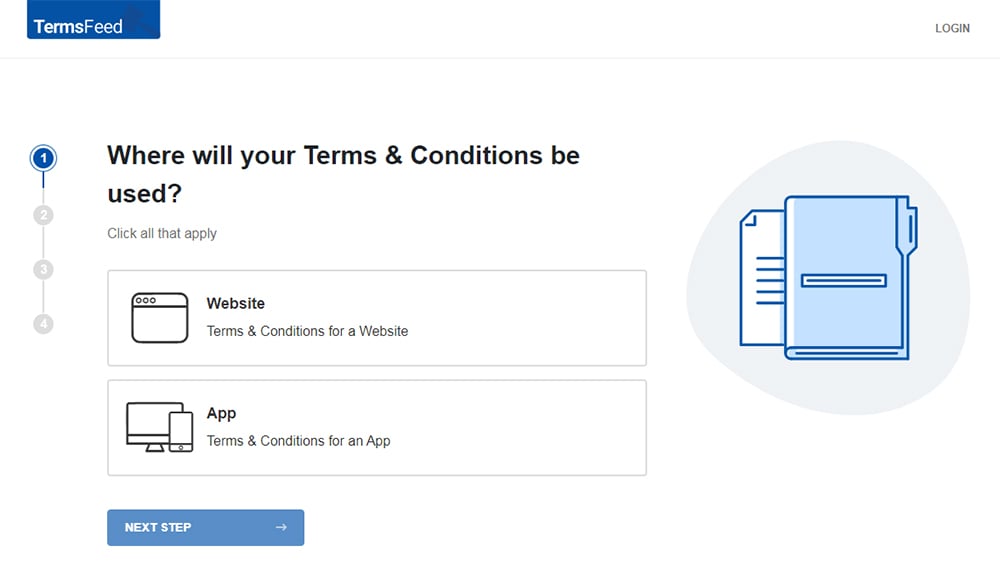
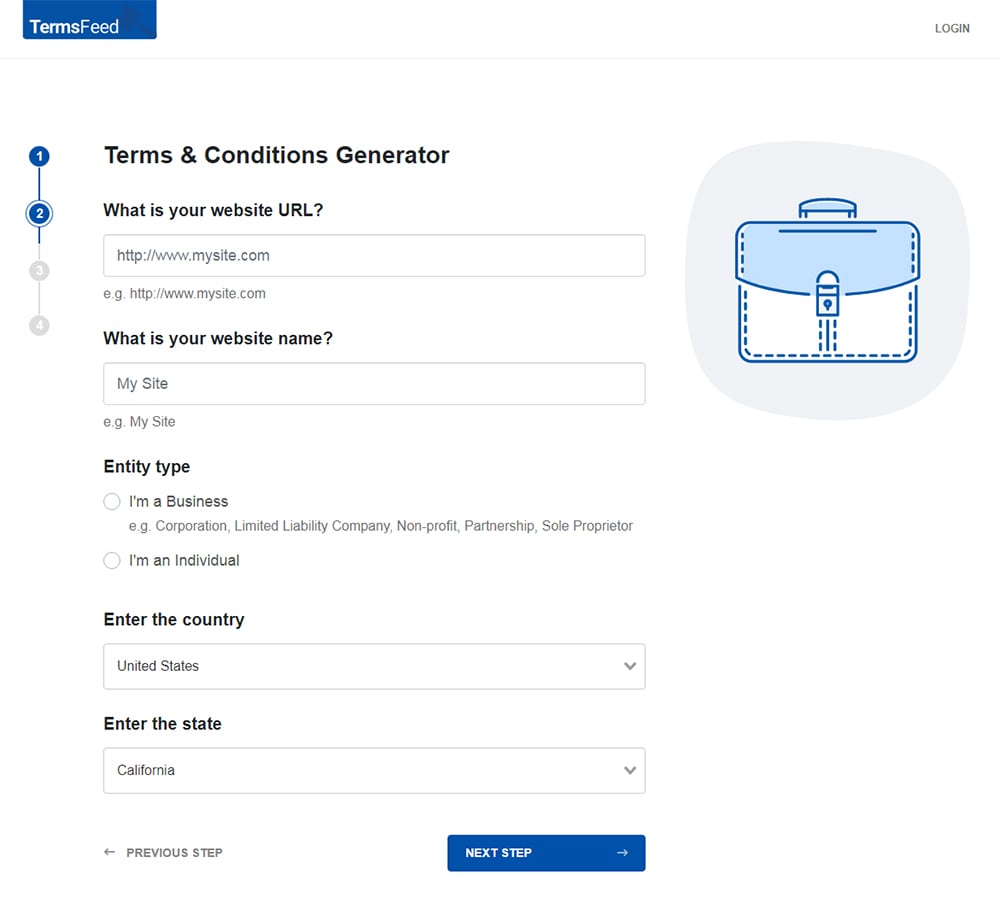
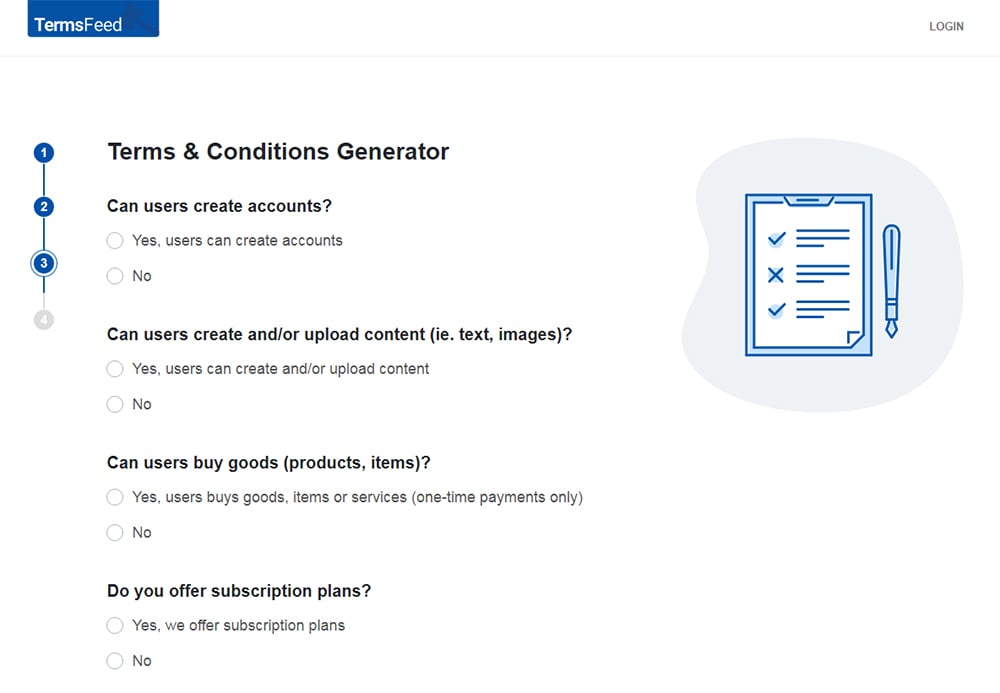
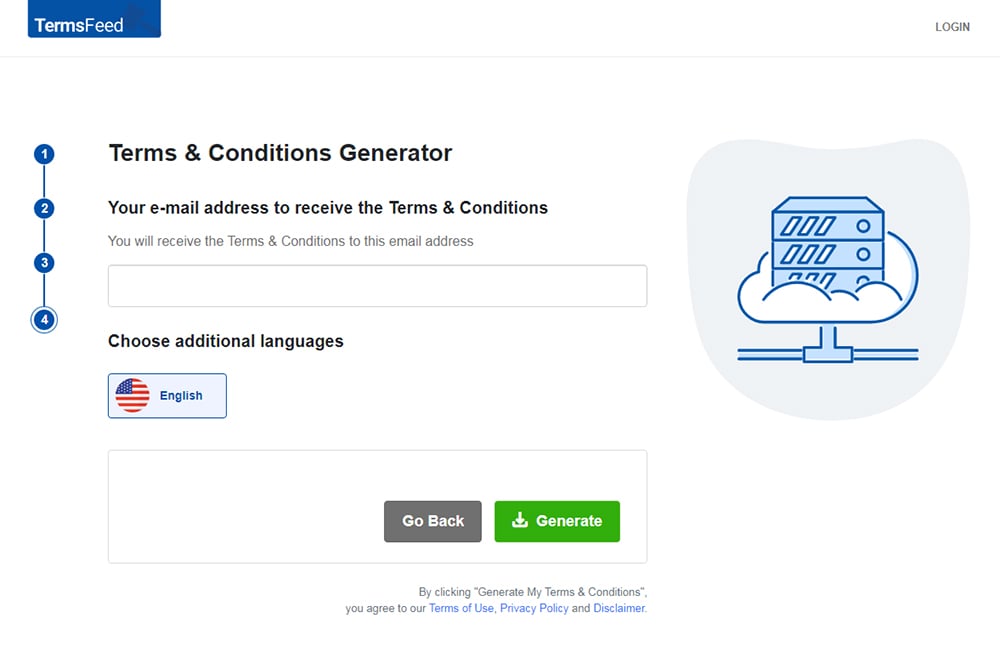 You'll be able to instantly access and download the Terms & Conditions agreement.
You'll be able to instantly access and download the Terms & Conditions agreement.A Terms and Conditions agreement is a contractual agreement that outlines the precise legal relationship between the dropshipper and customers.
Terms and Conditions agreements are also known as a Terms of Service agreement or a Terms of Use agreement.
Here's an example of a Terms agreement table of contents, so you can see what types of clauses are included:
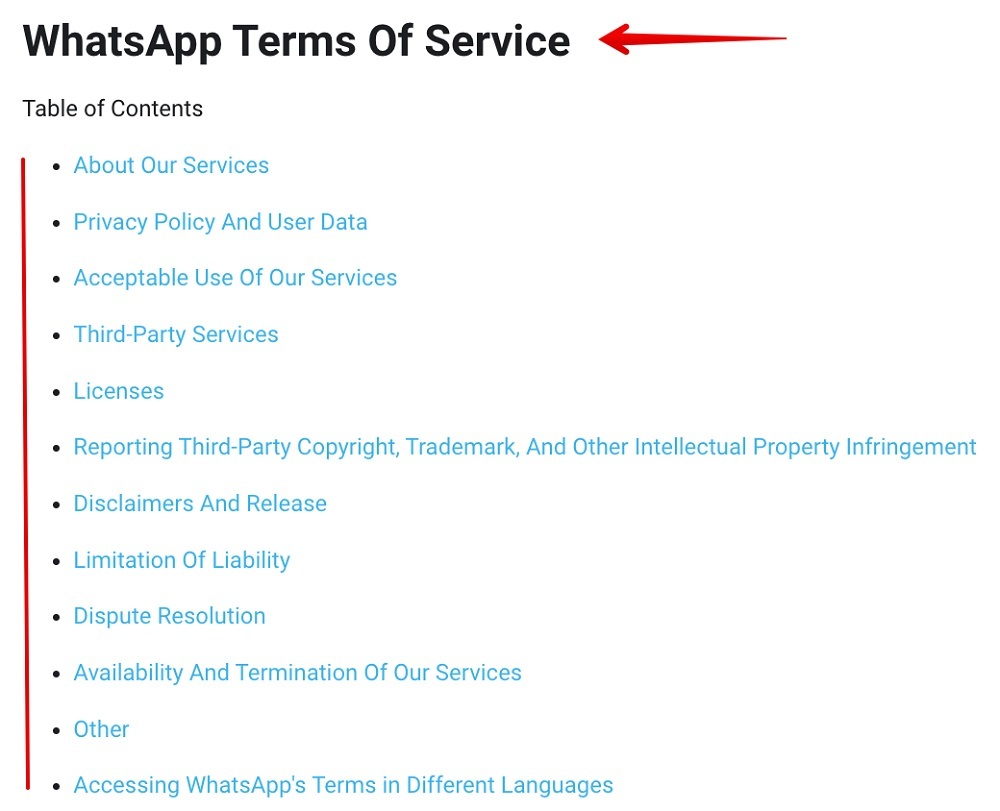
With a Terms and Conditions agreement in place, you create clear expectations for all parties. Moreover, you make it easier to take legal action if a customer attempts to take advantage and abuses your business.
A dropshipping Terms and Conditions agreement will ultimately work to convey the following information:

A Terms and Conditions agreement is written to protect you and your customers. You're able to be incredibly specific about what you can and cannot be held liable for and what actions you're able to take when wronged.
For example, you may describe in detail your policies regarding order cancellations and refunds.
Here's an example of how a dropshipping store cant note in its T&C that cancellations are only accepted under certain conditions:

You could also specify:
Recall that you're not legally bound to have a Terms and Conditions agreement. However, as a dropshipper, you should understand that a lot can go wrong between the moment an order is received and when the product is delivered to the customer.
Your Terms and Conditions agreement is a shield against the moments when things go badly.

Common sections to place within a Terms and Conditions agreement for your dropshipping website include:
Even though we listed some common clauses that many dropshipping websites include in their Terms and Conditions agreement, no fast and hard rule says you have to include all of them. Every T&C should be tailored to the needs of the business it covers.
With that said, we listed the clauses above for a reason. We'll go over each of these below.
Keep in mind when drafting your agreement that it's a best practice to ensure that all language used in the T&C is kept clear, simple, and easy to read. You should avoid legal jargon as much as possible.
The purpose of the introduction clause in your Terms and Conditions agreement is to let everyone know exactly to whom the agreement applies. The clause should outline:
The dropshipping site, Indestructible Shoes, does a great job of stating to whom its Terms of Service applies in its introductory clause, as seen here:

Some dropshippers combine several things regarding the overall rules of website use into one section. However, others break it up into a couple of subsections as both Indestructible Shoes and Men's Luxury Boutique do.
For example, both stores break their house rules into online store terms and general conditions. These sections outline rules concerning things such as giving implicit permission for the site to allow a user's children who are minors to use the site and agree that the user will not transmit viruses, worms, or any other malicious code.
Here's how the Men's Luxury Boutique lays it out:
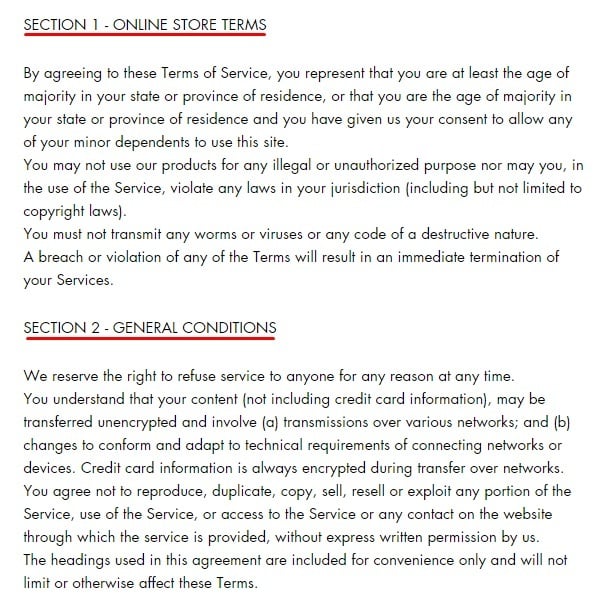
You should clarify what kinds of content and behavior you won't allow when it comes to your services.
For instance, here are some common things that businesses will disallow in a Terms agreement:
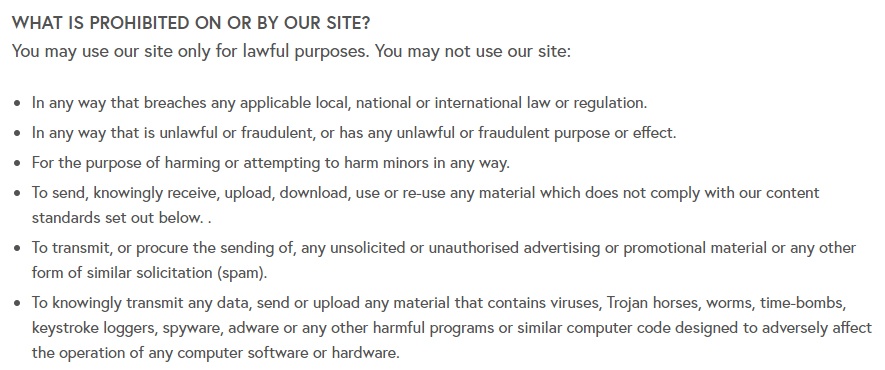
Here's an example of a clause that lists prohibited activities:
By including these types of demands in the Terms and Conditions agreement, websites make it easy to suspend or delete users that break the terms of service they've explicitly laid out. Indeed, Motrendy plainly declares that it reserves the right to terminate a site visitor's use of its service if that user violates any of the terms listed above.
Commercial branding materials, such as trademarks, slogans, or combinations thereof, are your intellectual property and need to be protected. You can do that by putting a clause in your T&C that details what users can and cannot do with it.
Here's an example:

You need to lay out in no uncertain terms what is expected when it comes to taking payment. For example, let customers know that they have a responsibility to provide accurate payment information when making a purchase.
Here's an example of this:
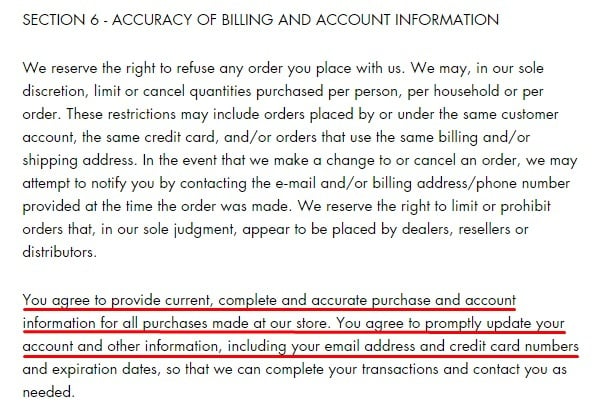
There are many things you can't guarantee won't happen when someone uses your website, and you don't want to be sued to kingdom come if one of those things takes place.
For example, you don't want to be liable if:
Therefore, it's a great idea to ensure that you're not, in fact, liable. Warmly goes so far as to practically say that the company isn't liable for anything at all, ever. except in some geographic locations.
As the company says in its liability clause:
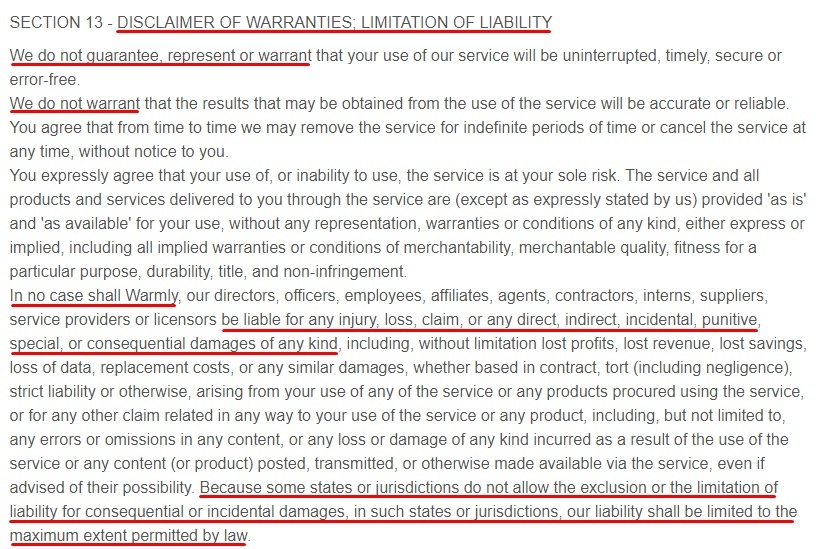
Not every dropshipper has the same policy when it comes to refunds and cancellations. It's a good idea, then, for you to mention this subject in your Terms and Conditions agreement and point to a specific Return and Refund Policy to avoid any confusion on the matter and to avoid future conflict with customers.
For example, a Terms agreement can include something like the following:

Note that the company's Terms of Service doesn't detail its return policy, but it does mention such a policy. It tells customers that information on returns is located in a separate, specific agreement on that subject.
Should conflicts arise, your customers need to know the legal process you follow to resolve them. You should also make clear under which state (or country's) laws dispute resolution will take place.
The Jurisdiction and Conflict Resolution clause (also sometimes called the Governing Law clause) is the place to put this information.
Here's how this can be done:

A clause that contains information on how your customers can contact you with any questions or concerns they might have is something that every Terms and Conditions agreement should include.
It's a best practice to give customers several ways in which to contact you. For instance, these could include:
Here's an example:
 How to Contact Us clause" width="1000" height="312" />
How to Contact Us clause" width="1000" height="312" />
Remember that providing multiple ways to contact your company helps build overall trust and professionalism.

It's important to recall that you should never bury your Terms and Conditions agreement in a place on your website where visitors will never find it. It should be displayed in an easily viewable and accessible location.
There are a few different places that are recommended.
The footer of your website might seem like a conspicuous location to place your Terms and Conditions agreement, but you might be amazed at how many dropshippers neglect to put it there. However, the footer is an excellent location since it meets the criteria suggested above.
The footer is easily viewable and accessible to all website visitors, and it's usually a part of every page on your website.
Here's an example:

Note that the mobile app equivalent of a website footer would be somewhere within an app's menu, such as within a Settings or More Info menu. You should add a link to your Terms and Conditions agreement in such a place within your dropshipping store's mobile app, like so:
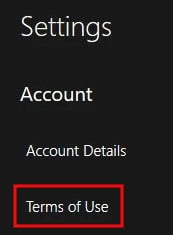
When people sign up for accounts with your dropshipping store, you can (and should) provide a link to your Terms and Conditions agreement in the form itself, along with a statement that lets users know they will need to agree to the terms.
This placement lets people view your terms before creating the account, which ensures that they're ok with actually agreeing with what you're presenting.
Here's an example from the Deepstash mobile app:
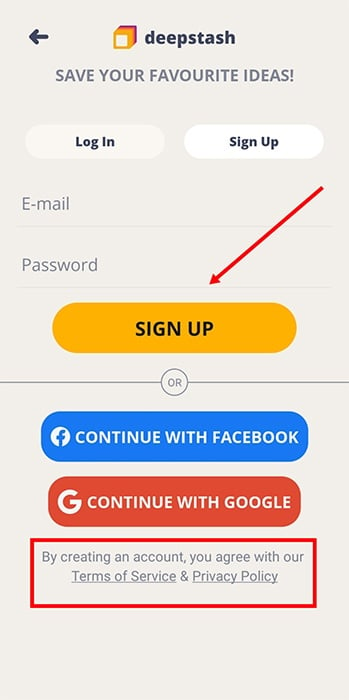
Another common place to display a Terms and Conditions agreement link is somewhere within the checkout pages of your dropshipping store. Customers must work through these pages to complete an order, so it's a good time to remind them that your Terms and Conditions agreement applies to the transaction.
Here's an example from H&M:

You can request users agree to your Terms as well before placing a purchase, such as is seen here:
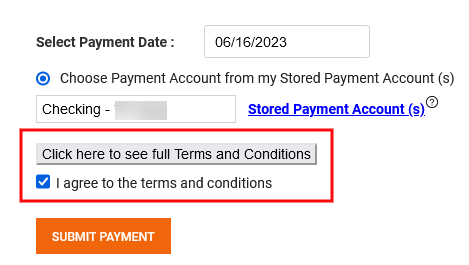
If you own a dropshipping store, you don't have to legally include a Terms and Conditions agreement on your website, but you should write and display one anyway. Remember that a proper Terms and Conditions agreement protects you from liability issues, while also helping to keep your customers informed about important aspects of your business.
You should always include clauses that govern:
Moreover, you should note that your Terms and Conditions agreement is subject to change at any time. The agreement should be explicit, written in plain language, and formatted so that your website's visitors can read it easily.
Finally, place your Terms and Conditions agreement in prominent, conspicuous locations like your website's footer and on account sign-up forms. If you feel there are other relevant locations, such as on login or checkout pages, place a link to your T&C there, as well.
Comply with the law with our agreements, policies, and consent banners. Everything is included.
Disclaimer
This article is not a substitute for professional legal advice. This article does not create an attorney-client relationship, nor is it a solicitation to offer legal advice.
Last updated on
Appears in
Related articles
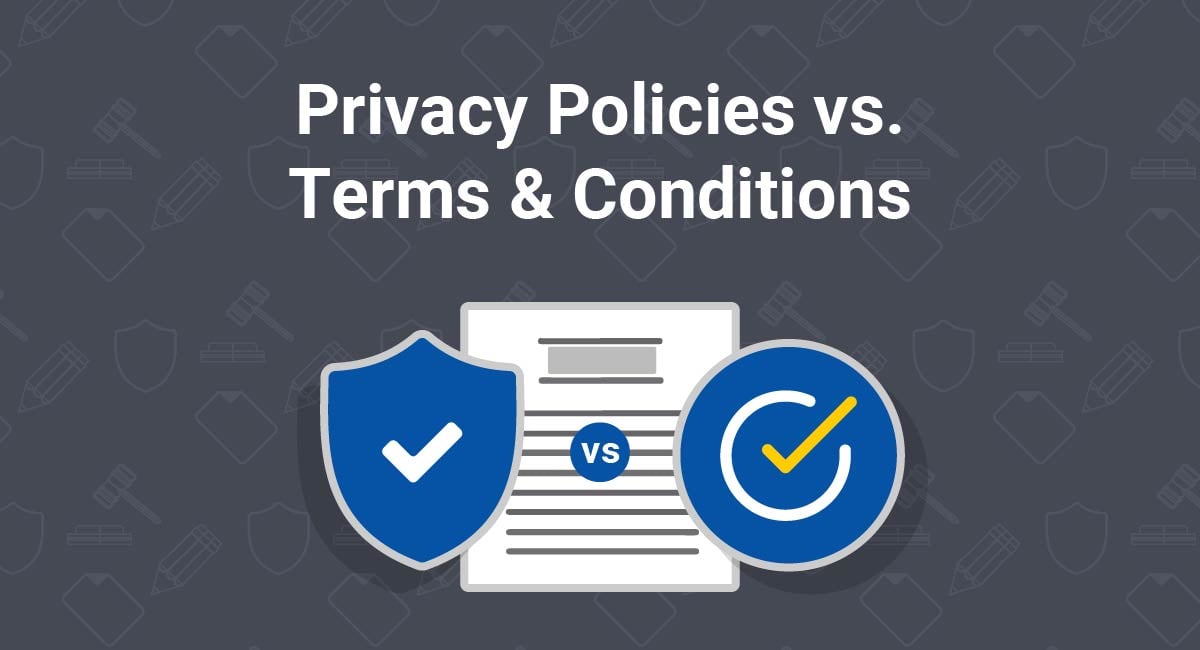
The main difference here is that a Privacy Policy is required by law if you collect or use any personal information from your users, e.g. email addresses, first and last names etc. while a Terms & Conditions agreement sets forth terms, conditions, requirements, and clauses relating to the use of.
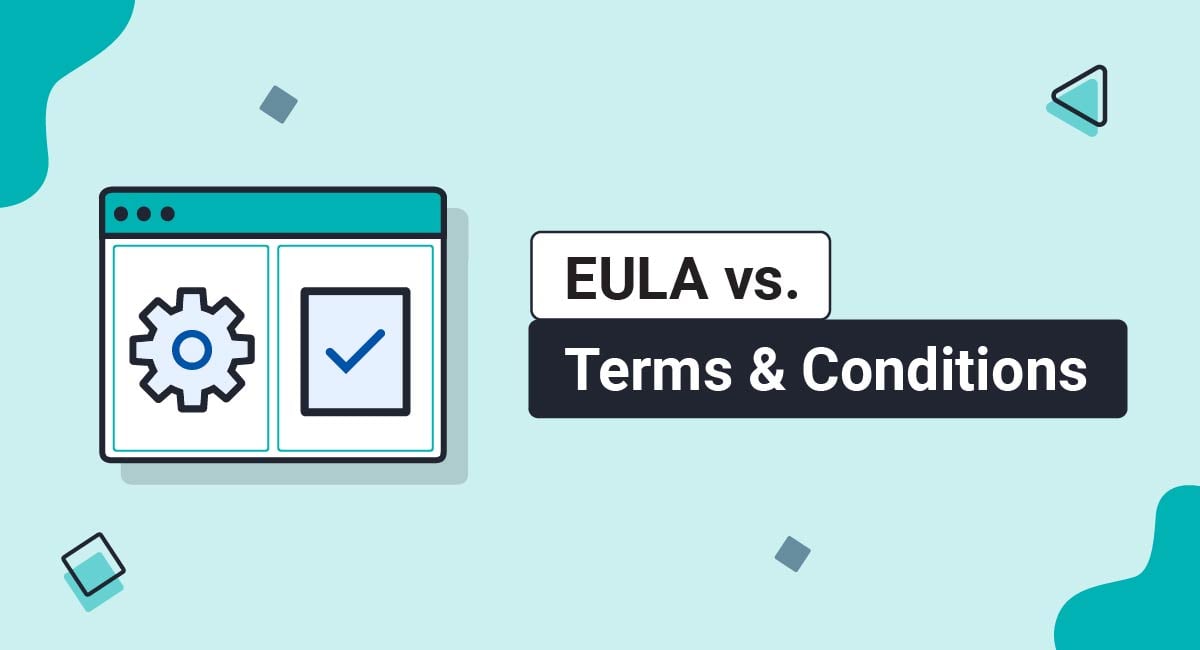
Whether you're a software developer, a service provider or an ecommerce company, practically every business requires a set of legal agreements between itself and its users. Two common and beneficial agreements are the End User License Agreement (EULA) and the Terms and Conditions agreement (T&C). Confused about which one you need.
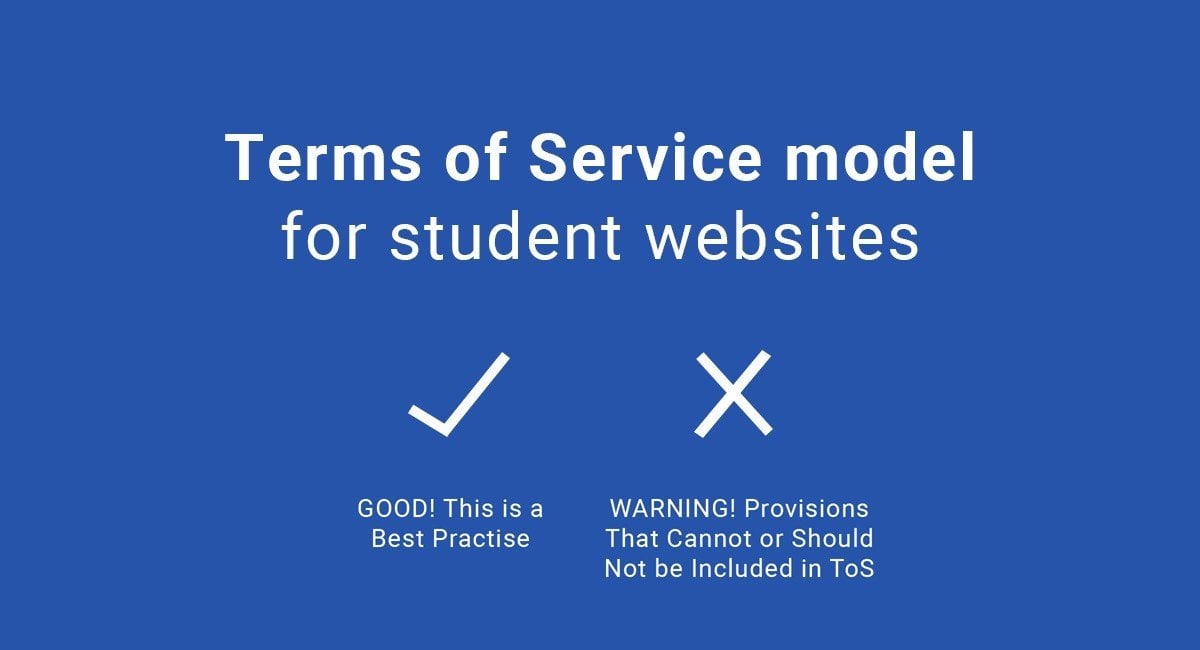
Student data privacy has been a hot topic in the last year or so and is only expected to gain momentum as educational services, websites, and mobile apps infiltrate classrooms everywhere, with students of all ages from elementary grades to university levels. As new bills, laws and legislation get passed, it's.
Comply with the law with our agreements, policies, tools and cookie consent banners. Everything you need is included.
Disclaimer: Legal information is not legal advice, read the disclaimer. The information provided on this site is not legal advice, does not constitute a lawyer referral service, and no attorney-client or confidential relationship is or will be formed by use of the site.
Copyright © 2012 - 2024 TermsFeed ® . All rights reserved.